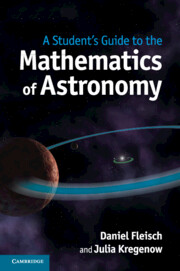4 - Parallax, angular size, and angular resolution
Published online by Cambridge University Press: 05 June 2014
Summary
One of the most important contributions that the science of astronomy has made to human progress is an understanding of the distance and size of celestial objects. After millennia of using our eyes and about four centuries of using telescopes, we now have a very good idea of where we are in the Universe and how our planet fits in among the other bodies in our Solar System, the Milky Way galaxy, and the Universe. Several of the techniques astronomers use to estimate distance and size are based on angles, and the purpose of this chapter is to make sure you understand the mathematical foundation of these techniques. Specifically, the concepts of parallax and angular size are discussed in the first two sections of this chapter, and the third section describes the angular resolution of astronomical instruments.
Parallax
Parallax is a perspective phenomenon that makes a nearby object appear to shift position with respect to more distant objects when the observation point is changed. This section begins with an explanation of the parallax concept and proportionality relationships and concludes with examples of parallax calculations relevant to astronomy.
Parallax concept
You can easily demonstrate the effect of parallax by holding your index finger upright at arm's length and then observing that finger and the background behind it with your left eye open and your right eye closed.
- Type
- Chapter
- Information
- A Student's Guide to the Mathematics of Astronomy , pp. 102 - 121Publisher: Cambridge University PressPrint publication year: 2013
- 1
- Cited by



